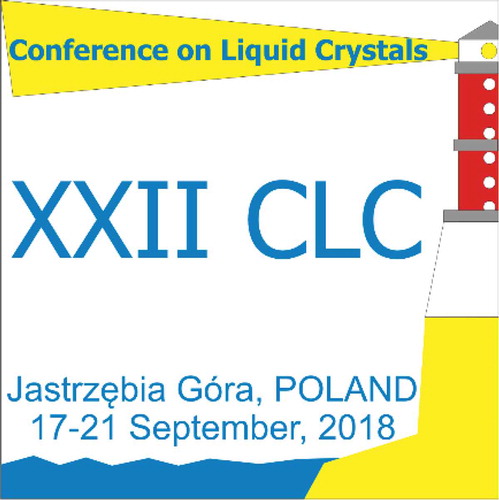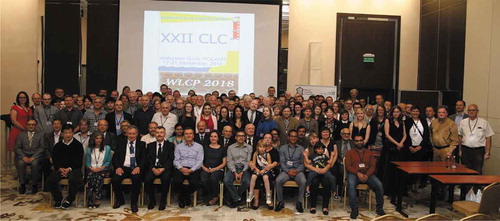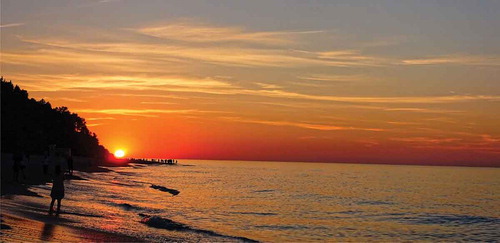The 22nd Conference on Liquid Crystals (chemistry, physics and applications) was held from 17 to 21 September 2018 in Jastrzębia Góra, a small village on the south coast of the Baltic Sea, 70 km north of Gdańsk (Poland). In this village, there is located the most northern point of Poland ().
Photo 1. (a) The monument of the most northern point of Poland (N 54°50ʹ08ʺ, E 18°18ʹ01ʺ) and (b) distances to capital cities of neighbouring countries from Jastrzębia Góra.

The Conference () was organised by the Institute of Applied Physics and the Institute of Chemistry, Military University of Technology in Warsaw (Poland) under the auspice of the Polish Liquid Crystal Society (PLCS). The rich history of Conference on Liquid Crystals [Citation1–Citation3] goes back to 1976. This year XXII CLC conference was organised in parallel with the ‘Workshop on Liquid Crystals for Photonics (WLCP 2018)’. Both meetings were at the same time and place, so the participants were able to attend both conferences. Plenary sessions and tutorials were common for participants of both conferences. The 174 participants of the CLC’18 and WLCP’18 came from 25 countries (). Among them 85 participants are from Poland. The majority of the participants are from Europe, but also from India, China, South Korea, Japan, Israel, USA, Brazil and Saudi Arabia. About 50 PhD students participated in these two meetings.
There were four plenary lectures and four tutorials, 19 invited talks and about 26 oral and 86 poster presentations, all covering a variety of topics – Synthesis and new materials. Phase structure and phase transitions (25.0% of all presentations); Chiral phases, ferroelectric and antiferroelectric liquid crystals (9.4%); Macroscopic and microscopic properties, the molecular dynamic, confined systems (15.6%); Electro- and thermo-optical effects, display and photonic applications (24.2%); Active, Photosensitive and Conductive Liquid Crystals (2,3%); Polymer liquid crystals and composite structures (3.1%); Theory and molecular modelling(7.0%); Nanomaterials and Nano-composites (8.6%); Lyotropic and phototropic liquid crystals (4.7%). This topical statistics reflects the fact that the LC community is strongly interested in new materials, their characterisation and applications.
The conference officially opened on Tuesday, but two tutorials were organised during the evening on Monday. The first tutorial was given by Gaetano Assanto (University ‘Roma Tre’, Italy). The tutorial discussed the basic features of optical spatial solitons, several interesting effects of nematicons were nicely illustrated. The talk also addressed recent results on soliton-enhanced random lasing with directional properties. The second tutorial was delivered by Victor Reshetnyak (University of Kyiv, Ukraine). In this tutorial, it was shown how to tune and control the surface plasmons in graphene/MoS2 ribbons and monolayer graphene by placing a LC slab on top of the ribbons or monolayer. There were presented some examples of the modelling, namely: surface plasmons excitation and tuning in a monolayer graphene with periodically anchored LC layer on top of it; controlling surface plasmons in graphene/MoS2 ribbons by manipulating the light polarisation with the help of a LC layer. This tutorial also discussed how liquid crystals allow controlling so-called Tamm plasmons in a system of distributed Bragg mirror and a conducting layer. Two more tutorial were given on Wednesday by Andrzej Miniewicz (Wroclaw University of Science and Technology, Poland) and Xabier Quintana (CEMDATIC, Universidad Politécnica de Madrid, Spain). Andrzej Miniewicz in his lecture gave an introduction to the second and third order nonlinear optical phenomena with special attention paid to photorefractive and photochromic effects. He has shown nice examples of using photorefractive LCs in dynamic holography, adaptive optics, optical switching and information processing. The photochromic effects were explained by giving examples of photochromic azobenzene derivatives which can be inserted either into LCs itself or into LC orientating layers. These materials allow, in particular, tuning of lasing in cholesteric LC, recording and controlling of polarisation gratings, enhancing Kerr effect, and many other interesting applications. Xabier Quintana in his tutorial reviewed the liquid crystal alignment mechanisms with the main focus onto their practical use. It was discussed different alignment techniques which are utilised in his laboratory for more than 25 years. Among them rubbing technique; photoalignment; alignment with microgrooves and nanoimprinted patterns, alignment using polyimide and polyamides, PEDOT:PSS; obliquely evaporated inorganic oxides like SiO2, SiOx; different ways to align lyotropic liquid crystals, antiferroelectric LCs and blue phases.
The scientific part of the Conference started with the plenary lecture given by Jan Lagerwal (University of Luxembourg, Luxembourg), who talked about phase separation in liquid crystals. He has presented two very different in nature examples of phase separation. In the first case, the system is made of a thermotropic liquid crystal and a solvent, it phase separates into two distinct isotropic phases. In the second case, isotropic-nematic phase separation takes place in an aqueous suspension of rod-like nanoparticles. The phase separation first leads to so-called tactoid formation, then to macroscopic division into two fractions. There were three other plenary lectures. Norbert Fruehauf (University of Stuttgart, Germany) talked about liquid crystal light modulators for non-display applications. Particular examples of these applications are large area applications, such as adaptive windows and intelligent headlights for cars. He has highlighted design and technology challenges as well as manufacturing and system integration issues, and convinced the participants of the Conference that there are interesting opportunities for commercialisation of non-display liquid crystal technologies and LCs have a bright future. Kristiaan Neyts (Ghent University, Belgium) discussed complex three-dimensional director patterns formed in the LC cell due to the periodic anchoring induced on the two substrates by using the photoalignment technique. Particular interest presents periodic planar-homeotropic anchoring. The forth plenary lecture was given by Oleg Lavrentovich (Kent State University, USA). He covered various aspects of electro-optics of oblique helicoidal cholesterics (Choh). Electrically tunable selective reflection of light in this cholesterics occurs in a broad spectral range going from ultraviolet to visible and to infrared. It is also possible to have electrically tunable lasing in oblique helicoidal cholesterics.
There were also a large number of excellent oral and poster contributions. I personally enjoyed the talks on: synthesis of new LCs exhibiting twist-bend nematic phase (Corrie T Imrie) and highly birefringent LCs with wide temperature range and low viscosity (Zhongwei An); adding azo-groups to bent-core LCs (Michal Kohout); high birefringent alkylthio-containing rod-like mesogens (Yuki Arakawa); characterisation LCs mixtures in the visible, near, short and medium infrared spectral regions (Wiktor Piecek); nematic monopoles in the dowser texture (Paweł Pierański); transparent optical elements made with photoalignment technique (Masanori Ozaki); liquid crystalline cellulose-based responsive materials (Maria Helena Godinho); LCs made from nanoparticles and graphene oxide, liquid and liquid crystal-ferrofluid dispersions (Ingo Dierking); chiral structures from achiral lyotropic liquid crystals (Clarissa Dietrich).
Photo 4. Chairmen of Scientific Committees Wiktor Piecek (CLC) Tomasz Woliński (WLCP), and chairman of Organizing Committee (President of PLCS) Jerzy Zieliński and vice-president of PLCS Monika Marzec.
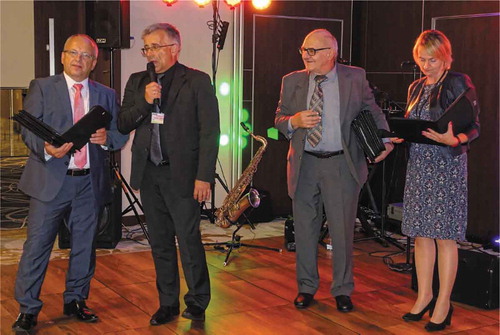
Photo 5. Group photo of all awarded persons. From left side: Sebastian Lalik, Zeinab Parsouzi, Rebecca Walker, Katarzyna Lekenta, Katarzyna Gaładyk, Anna Drzewicz.
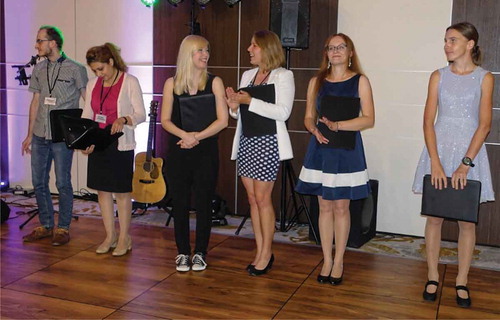
During the CLC’18 conference, the competitions for the best poster and best oral presentations were organised (). The best oral presentation prize was given to Anna Drzewicz for the talk ‘Vibrational spectra of chiral smectic liquid crystals differing in the molecular and helicoidal structure’, she is a PhD student from Military University of Technology (Poland); and two diplomas were awarded to Katarzyna Gaładyk ‘Smectic liquid crystal of near constant tilt angle in a broad temperature range’, a PhD student from Military University of Technology (Poland); and Katarzyna Lekenta ‘Optical spin Hall effect in a liquid crystal microcavity with tunable TE-TM splitting’, PhD student from University of Warsaw (Poland). The best poster presentation prize went to Rebecca Walker ‘Chirality and the twist-bend nematic phase’, PhD student form University of Aberdeen (UK); and two diplomas were given to Zeinab Parsouzi ‘Comparison of material parameters among dimer, trimer, and tetramer homologues in the nematic phase’, a PhD student from Liquid Crystal Institute – Kent State University (US); and Sebastian Lalik ‘Physical properties of binary eutectic ferroelectric mixture’, a PhD student from Jagiellonian University (Poland). All of these prize winners done excellent research and their talks and posters at the Conference were outstanding.
In addition to the scientific activities, the participants of the Conference had opportunities to enjoy hotel’s spa, walk along sea beach and see the wonderful sunsets (). Some delegates even swam in a moderately cold sea-water. The Bonfire with the local traditional folk music band and Banquette with band singing Polish and international songs were also nice events with a variety of Polish food, bear and wine.
My personal impression from the Conference is very positive. I’m sure that all participants enjoyed an excellent and very diverse scientific programme covering almost all aspects of liquid crystal science both fundamental and applications. The Organizing Committee led by Jerzy Zieliński (chairman) and Scientific Committee led by Wiktor Piecek (chairman) and Przemysław Kula, Paweł Perkowski, Marzena Tykarska (co-chairmen) have done a great job.
References
- Marzec M. XVIII conference on liquid crystals (chemistry, physics & applications). Liq Cryst Today. 2010;19(1):26–27.
- Kumar S, Dhar R. 19th conference on liquid crystals (chemistry, physics and applications). Liq Cryst Today. 2012;21(2):42–44.
- Glogarova M. Twenty-first conference on liquid crystals (chemistry, physics and applications). Liq Cryst Today. 2017;26(1):17–20.

